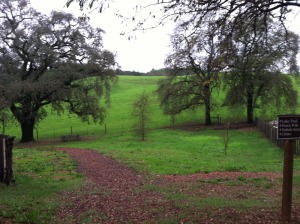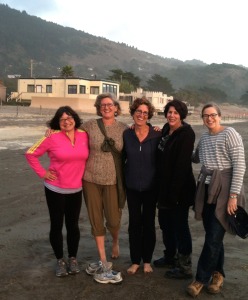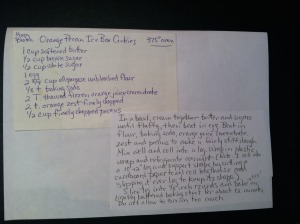I just spent four days in silence. Every year, I load up the car with warm comfy clothing, good walking shoes that can get wet, ample reading material, knitting, my rosary beads (the Anglican rosary, which I’ve been carrying around for almost twenty years) and prayer book, and drive up to Healdsburg. To, specifically, the Bishop’s Ranch on the west side of Healdsburg, in the Russian River valley. This year, it poured rain pretty much nonstop, a welcome saturation in these years of drought, for those above flood level at least. I arrived at the Ranch around four o’clock on Sunday, and feasted my eyes on the green and my ears on the quiet.
It’s an odd thing, to choose to spend time this way. Intentional silence is so utterly alien to most of our lives, even for those of us who—alone in the house or car— often choose quiet. I turn on music or the radio occasionally and check my email at red lights just like the rest of you. And it’s not as if silence is purely silent, anyway, right? Silence is full of sound, depth and texture. Often, that sound is the chatter in my own mind– talking, ruminating, cross-examining, pondering. And during times of despair, worry, and anxiety, that chatter can be so much more painful when surrounded by quiet. Without distraction, the fretting mind goes into overdrive. Nothing peaceful in that.
Silence doesn’t necessarily bring bliss—or perfection or even spiritual elevation. I thought uncharitable thoughts about my fellow retreatants, just little nitpicky things that, in the full light of silence, came to stark relief against my knowing (and wanting) better. Silence isn’t always full of love. But it does burn away a certain level of dross in our lives, a kind of refining fire. I also sat with people I see only during this week each year, and yet I feel closer to them than to many people I talk to regularly all year long. Silence in community breeds a deep intimacy, a sweet sweet fellowship. Why are we so afraid of it? I know I am, rushing to fill any gap in conversation, especially when I’m with someone I don’t know very well, and yet I soak this experience up the way a blotting paper absorbs ink.
Each morning, I walked the trails on the ranch. Rain, mud, grazing cattle, rushing creeks. As I neared the top of one of the hills, I spotted a manzanita tree and smiled in recognition. Here, too, was a companion from years past, a companion in silence. I went over to touch its smooth, wet bark, to see the new glossy reddish-brown layer being revealed under the scab of last year’s bumpy black bark. It felt like wood, yes–like a banister or a walking stick–but almost imperceptibly I could feel the life inside it. I felt a little silly, and a bit like some caricature of a woman on spiritual retreat, palming the bark of trees, and yet it felt like the only thing I wanted to do that moment.
I also worked on jigsaw puzzles and splashed in puddles, the way I had as a child, walking home from school on rainy days. With the luxury of dry socks and shoes in my room, and hot water in the shower, I let my feet get deliciously wet. I made craftsy projects–gifts, bookmarks, note cards, stars to hang from fish wire in the chapel. I got smears from pastels and glue sticks on my fingers, glitter in my hair and the fabric of my pants. Hours slipped by.
So back to the question. Why manzanita? It’s the tree pictured as the background to this website, and I chose it with a kind of inevitability. I don’t recall when I learned to distinguish a manzanita from, say, a bay or an oak or a madrone. Growing up, I knew them all by sight but I rarely cared about the names, relying on plants more for what they could be used for–sour grass for sucking the stems, miner’s lettuce for chewing the leaves, ice plant bunches for tossing in hopscotch (much better than rocks because ice plant stays where it lands). It’s the name, too, the musicality of the word, and that gorgeous reddish brown color. It speaks of California to me, to the hillsides where you round a bench or reach a summit and there, a familiar friend, it is.
What about you? What tree or plant feels special to you? And what have you learned from silence?





